Chapter 6
The Suit of Music
THE CELEBRATION OF LIFE FORCE.
FEELING WITH HEART
& SOUL.
THE PATH OF LOVE & BEAUTY.
I love the jocund
dance, The softly-breathing song.
—Characteristics
of the Suit
—The Number Cards
1-Passion
2-Contraries
3-Exuberance
4-Musing
5-Melancholy
6-Pleasure
7-Fancies
8-Discontent
9-Happiness
10-Sublimity
—The
Person Cards
Angel
of Music
Child of Music
Woman of Music
Man of Music
Characteristics
of the Suit
The Creative Process Suit of Music
represents the emotional uses of divine imagination. It corresponds to the Suit
of Cups in conventional Tarot. Its symbol is the lyre, an ancient stringed instrument
whose name means 'to laud in song'. The earliest lyres were made by stringing
animal horns, and its seven strings were the basis of todaysÕs musical scale.
The lyre was sacred to Orpheus, Greek god of music, and was honored in the stars
as the constellation Lyra. Luvah, the Zoa of Emotions, presides over this suit,
whose element is Fire. Music is associated with passion, the sense of smell,
and abstract precision such as in musical theory and mathematics. The cards
in this suit portray situations and states of being that pertain to human feelings,
especially love, as related to the power of imagination. When pertaining to
works of art, Music specifically includes the study and practice of such disciplines
as music ('art of the muses'), dance ('to move or stretch'), and weaving ('the
art of webbing'). It also includes activities related to fire, such as chemistry
('pouring and melting'), alchemy ('mixing of fiery fluids'), perfumery ('through
the smoke' [incense]), and cooking — the latter two being related to both
fire and smell. Anything related to emotional causes is part of this suit, because
the highest power of music is its ability to kindle the emotions. In addition,
because of the mathematical and harmonic structure underlying music, the suit
also applies to law and mathematics, although these are "degraded"
or fallen forms because they seek to bypass spiritual vision. In general, Blake
associated music with the idea of transcendence, and therefore uses musical
symbols throughout his art to represent spiritual and imaginative states.
Basically, the Suit of Music is
about one's spiritual vibration or energy, and its expression through the use
of imagination. Music relates to the world through the heart and emotions. The
true musician-dancer-weaver-alchemist inspires love and creates emotional beauty
in the external world by using the imagination, whereas the "degraded"
musician rationalizes or regiments feelings to suppress the imagination, as
in the following description of Urizen:
He formed also
harsh instruments of sound
To grate the soul into destruction or to inflame with fury
The spirits of life to pervert all the faculties of sense.
The borders of all the suit cards
depict flames and smoke symbolizing the heat and passion of the emotions, and
its element of fire. (Swedenborg defined love as spiritual fire.) The inner
edges of the card borders are red to symbolize the suit element. Each card has
a Symbol Window at the bottom whose faint design of wavy lines suggests the
vibrations of energy (and music) that characterize this suit. Each card also
contains a thematic quote from Blake that extends its meaning and emulates lyrics
to music. They are like Blake's "sounds of spiritual music and its accompanying
expressions of articulate speech."
The Number
Cards
The ten Number Cards in the Suit
of Music are all from Blake's watercolor designs to Poems by Mr. Gray, giving
them both visual and symbolic continuity. Blake's book of designs illustrated
12 poems by Thomas Gray, a poet whose work Blake admired. A single copy was
commissioned by a patron as a gift for his wife; thereafter the existence of
these designs was unknown to the public for over 100 years.
Ace of
Music — Passion
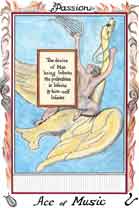 This
card shows a naked youth astride a giant swan ascending in full flight. In one
hand he holds an upraised lyre and in the other a pair of reins. The opening
illustration to Gray's book, it represents Genius being carried by Inspiration.
In Blake's symbology, upward flight signifies energy — the life force associated
with man's desires. The swan embodies purity, grace, and fertility, in union
with the youth's naked innocence. In Greek mythology, the swan is the mount
of Apollo, the god of music whose instrument was a lyre, and who Blake related
to the divine imagination. The lyre is the instrument of Luvah, the Zoa of Music.
Its shape symbolizes sexual energy, for the sounds rising from between its horns
are said to have initiated the birth of the universe. Traditionally, the lyre
has either seven strings (representing the planets) or twelve strings (representing
the astrological signs), and thus unites the forces of the cosmos. The reins
in his right hand show that you, as Apollo/Luvah, can control and direct these
creative energies.
This
card shows a naked youth astride a giant swan ascending in full flight. In one
hand he holds an upraised lyre and in the other a pair of reins. The opening
illustration to Gray's book, it represents Genius being carried by Inspiration.
In Blake's symbology, upward flight signifies energy — the life force associated
with man's desires. The swan embodies purity, grace, and fertility, in union
with the youth's naked innocence. In Greek mythology, the swan is the mount
of Apollo, the god of music whose instrument was a lyre, and who Blake related
to the divine imagination. The lyre is the instrument of Luvah, the Zoa of Music.
Its shape symbolizes sexual energy, for the sounds rising from between its horns
are said to have initiated the birth of the universe. Traditionally, the lyre
has either seven strings (representing the planets) or twelve strings (representing
the astrological signs), and thus unites the forces of the cosmos. The reins
in his right hand show that you, as Apollo/Luvah, can control and direct these
creative energies.
The quotation in the window declares
man's passion for life, which must be matched by an infinite capacity to live
life.Thus the card shows your unlimited ability to 'ascend to heaven', to open
yourself to dreams and especially to your own feelings — to soar on wings
of inspiration to the heights of your loftiest desires, and to lovingly perceive
the unlimited nature of life.
This card is about giving yourself
completely over to the feelings of the moment. 'To desire' means 'to long for
the stars' and now, on the wings of your imagination, you can get there. You
seek elegance and majesty beyond the influence of finite things. This is the
realization that you are an unlimited being. We all have a genius and passion
for something higher. When this card appears, look for a sign of where your
passion lies.
In the creative process, this is
when you desire to possess or achieve something with passionate intensity. Let
your genius soar upon your inspiration, and go for it.
KEYWORDS: PASSION FOR LIFE •
UPLIFTING EMOTIONS • FEELINGS OF ONENESS • OPENING TO FEELINGS •
CREATIVE BREAKTHROUGH • RECEPTIVITY TO PSYCHIC, SPIRITUAL, OR UNCONSCIOUS
CHANNELS • AWARENESS OF YOUR INFINITE POTENTIAL •
2 of Music
— Contraries
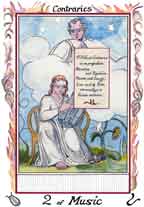 This
card shows Reason looking down from the clouds of matter, hearkening to the
gentle vibrations of Imagination's song — as the scientist Isaac Newton
listens to John Milton sing — illustrating Gray's lines from his "Ode
to Music":
This
card shows Reason looking down from the clouds of matter, hearkening to the
gentle vibrations of Imagination's song — as the scientist Isaac Newton
listens to John Milton sing — illustrating Gray's lines from his "Ode
to Music":
Milton struck
the deep-ton'd shell
And, as the choral warblings round him fell,
Meek Newton's self bends from his state sublime,
And nods his hoary head, and listens to the rhyme.
Milton is poetic inspiration, Newton
is rational inspiration; their essences are quite different yet augment each
other. Blake believed that consciousness can be posited in terms of "contrary
states" of existence, which are unique and necessary to each other. In
this instance, Newton represents reason or science, while Milton represents
the contrary state of energy or imagination. Contraries are not opposites (which
negate each other) but are interactive components of a whole, much like the
oriental concept of yin and yang. The opposite or negation of imagination is
vegetated dullness. Mercy and justice are contraries, while the negation of
mercy is cruelty. Other major Blakean contraries are: heaven & hell, joy & woe,
innocence & experience, liberty & society, convention & revolt, ecstasy & despair,
and time & space. Putting these terms together we discover such poetic and mystical
paradoxes as: conventional revolt, revolting conventionality, the ecstasy of
despair, crying for joy, a liberal society, innocent experience, heaven in hell,
and rational images.
In the card, Milton sits right foot
forward, his right hand plucking the strings of a seashell lyre; he represents
the spiritual sentiments, and his long hair signifies freedom of expression.
The moon-white lily and golden sunflower beside him nod in concordance with
the music, further affirming the idea of contraries. Amidst the stars of intellect,
Newton's cropped curly hair suggests tidy self-control. In sum, Blake endorses
the art of feeling, and the art of thinking. The presence of contraries intensifies
any experience.
This card also depicts archetypal
male and female symbols: the starry sky-father in the clouds communing with
the floral and lyrical earth-mother below. Their partnership creates the essential
unity of life. They represent all contraries within ourselves that need to recognize
and respect each other. Instead of having to make a choice as in the other suits,
here there is a healing of differences.
In the creative process, this is
when the tension of contrary forces propels you into the imaginal realm to find
solutions or new possibilities. Contraries need the presence of each other to
elicit the fullest expression of both.
KEYWORDS: INTERPLAY OF CONTRARIES
• ALLOWING FOR PARADOX • RESPECT AND COMPASSION FOR THE OTHER •
OPPOSITES ATTRACT • EMOTIONAL FREEDOM AND PSYCHIC WISDOM • EMOTIONAL
ISSUES OR CHOICES • PARTNERSHIP OR FRIENDSHIP • BALANCING THE MALE
AND FEMALE • AFFINITY DESPITE DIFFERENCES •
3 of Music
— Exuberance
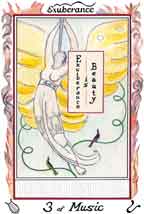 This
card is a collage of two illustrations for Gray's poem, "Ode for Music."
It depicts an ascending seraph with many-plumed wings, trumpeting a great musical
riff upwards into the heavens. Represents the vitality and and joy of life,
its upward movement suggests growth, especially of spiritual awareness. The
seraph ('radiant, burning one') is the highest order of angel, one who sounds
the music of the spheres (the rotating planets). Its celestial passion is evident
in the color of its wings, complemented by the flames in the border. On its
tunic we see dancing figures of energy like those in the 10 of Music. Below,
two small birds on looping tendrils join in the song. Nature cooperates with
spirit, forming an exuberant chorus. Angel, birds, and horn all symbolize transcendent
communication. The two birds independently signify fellowship and friendship.
This
card is a collage of two illustrations for Gray's poem, "Ode for Music."
It depicts an ascending seraph with many-plumed wings, trumpeting a great musical
riff upwards into the heavens. Represents the vitality and and joy of life,
its upward movement suggests growth, especially of spiritual awareness. The
seraph ('radiant, burning one') is the highest order of angel, one who sounds
the music of the spheres (the rotating planets). Its celestial passion is evident
in the color of its wings, complemented by the flames in the border. On its
tunic we see dancing figures of energy like those in the 10 of Music. Below,
two small birds on looping tendrils join in the song. Nature cooperates with
spirit, forming an exuberant chorus. Angel, birds, and horn all symbolize transcendent
communication. The two birds independently signify fellowship and friendship.
The word 'exuberance' itself means
an abundance or overflowing (from 'udder', hence 'to be fertile', to gush with
nourishment), and is akin to 'enthusiasm' ('filled with god'). In Blake's eyes,
exuberance is beautiful because it is filled with spiritual nourishment. The
emotion of exuberance is infectious because it has the ability to 'feed' others.
This card shows you blowing your
own horn, and singing with joy. Everyone around you shares in the good feelings.
You announce good news, and broadcast your enthusiasm for something. You are
lifted by happiness, calling attention to the beauty or special qualities of
something or someone. When this card turns up, there is often something special
or wonderful that you don't want to miss. It may simply be your wake-up call
to appreciate who and what's around you, and communicate how you feel.
In the creative process, this is
when you get so excited about something that you can't hold your feelings back.
This is a 'Eureka' experience that makes you blow your horn and sing your song.
This is a time to 'pour it on'.
KEYWORDS: EXPANSIVENESS •
CELEBRATION • ENTHUSIASM • LIVELINESS • SPIRITUAL GROWTH •
MUTUAL FELLOWSHIP • SPIRITED COMMUNICATION • SHARING OF IDEALS •
COMPROMISE • HEALING • GIVING THANKS •
4 of Music
— Musing
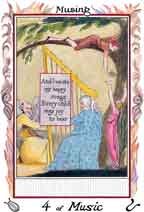 This
card is a collage of two watercolors, and depicts an ancient bard playing his
harp at a ceremony, while in the background a boy in a tree leans to hand down
a nest to a girl below. The bard, a favorite figure of both Blake and Gray,
represents the mythic poet-musician-prophet who speaks the truth (soothsays)
about past and present, and can divine the future as well. (See Man of Music.)
The scene in this card is similar to that illustrating Blake's poem from Songs
of Innocence, "The Voice of the Ancient Bard," which shows a bard
surrounded by young people as he sings: "Youth of delight come hither,
and see the...image of truth new born." With powers indicated by his starry
robe, the bard is an intermediary between the worlds of matter and imagination.
His eyes are closed as he looks within and muses upon what he sees with his
spiritual sight. In general, the bard signifies the passion of wisdom. As the
window quotation states, this is Blake himself, conveying his musings in words
and song to audiences old and young.
This
card is a collage of two watercolors, and depicts an ancient bard playing his
harp at a ceremony, while in the background a boy in a tree leans to hand down
a nest to a girl below. The bard, a favorite figure of both Blake and Gray,
represents the mythic poet-musician-prophet who speaks the truth (soothsays)
about past and present, and can divine the future as well. (See Man of Music.)
The scene in this card is similar to that illustrating Blake's poem from Songs
of Innocence, "The Voice of the Ancient Bard," which shows a bard
surrounded by young people as he sings: "Youth of delight come hither,
and see the...image of truth new born." With powers indicated by his starry
robe, the bard is an intermediary between the worlds of matter and imagination.
His eyes are closed as he looks within and muses upon what he sees with his
spiritual sight. In general, the bard signifies the passion of wisdom. As the
window quotation states, this is Blake himself, conveying his musings in words
and song to audiences old and young.
The background children are innocently
involved in their own musings as well, with the young birds representing 'lines
of communication' between them (the birds are called "captive linnets"
— a species whose name derives from 'lines'.) There is a sense of relaxation
and play, and shared feelings in this card, for the bard entertains his peers
while the children. This can represent reflective nostalgia, or 'remembrance
of things past' — a rich source for creative art.
In the creative process, this is
when you relax into playfulness, whimsically experiment with improvisation,
or reminiscence about past experiences. Such meditations alleviate stress and
refresh the imagination. Make space for the gifts of spirit to move through
you.
KEYWORDS: CONTEMPLATION OF HEART
AND SOUL • IMAGINATION AT PLAY • PLEASURE COMBINED WITH PURPOSE •
PASSIVE RECEPTIVITY • PLAYFUL OR FANCIFUL COMMUNICATION • RELAXING
PURSUITS •
5 of Music
— Melancholy
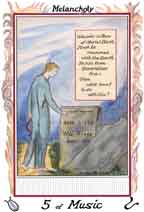 This
card depicts the "unlettered Muse" of Gray's most famous poem, "Elegy
Written in a Country Churchyard," standing amidst several tombstones. Her
finger traces the letters of the words, DUST THOU ART, beneath which the inscription
says, HERE LIETH WM BLAKE. As a spirit figure, the muse touching the gravestone
signifies the possession of psychic powers. The tombstones generically symbolize
the death of love, emotional loss, broken vows, or plans overturned. They can
also signify one's own buried emotions. Gray's poem is a melancholy speculation
on mortality and immortality; Blake's name upon the tomb is his own ironic gesture
of empathy.
This
card depicts the "unlettered Muse" of Gray's most famous poem, "Elegy
Written in a Country Churchyard," standing amidst several tombstones. Her
finger traces the letters of the words, DUST THOU ART, beneath which the inscription
says, HERE LIETH WM BLAKE. As a spirit figure, the muse touching the gravestone
signifies the possession of psychic powers. The tombstones generically symbolize
the death of love, emotional loss, broken vows, or plans overturned. They can
also signify one's own buried emotions. Gray's poem is a melancholy speculation
on mortality and immortality; Blake's name upon the tomb is his own ironic gesture
of empathy.
Melancholy ('black bile') is a deep
and bitter emotional sadness, often produced by the contemplation or experience
of death or extreme loss. In Blake's time, melancholy was widely believed to
be the wellspring of inspiration, providing both the topic and motivation for
much art. Although Blake himself at times went woefully "walking along
the darken'd valley, with silent melancholy, he believed it to be "a disease
which God keep you from & all good men." Sorrow or grief may result in
creativity, but happiness and joy are preferable, by far. Ultimately, this card
declares the necessity of transcending sadness: the muse's lyre itself connotes
energy and life; and she leads with her right or spiritual foot.
In the quotation window, Blake tells
us that the grave is the ultimate way to spiritual freedom. His last line, "Then
what have I to do with thee?" echoes Jesus speaking to his mother at the
marriage in Cana. This haunting question may be a repudiation of friendship,
family, and the ties to life — a statement of existential melancholy; or
it can be interpreted as a statement of spiritual necessity: no one can pursue
the spiritual path without first forsaking the ties of the material world —
which may include emotional ties, even this vegetable life itself.
This card is about being in low
spirits, perhaps from a disappointment or loss. At worst it portrays an apathy
or glumness that can be deadly to your creativity. The point is not to make
it habitual, or better, to break free from it. Use these times to get in touch
with your deepest feelings, to trace them to their source. By following your
feelings into your depths, you may be able to free yourself from old pains and
sorrows.
In the creative process, this is
when you convert the pain of disappointment or loss into artistic expression.
Or it may mean letting go of something old or dead, and moving on to something
new and alive. Or the let-down or dissociation that follows intense effort.
KEYWORDS: SORROWS AND REGRETS
• AWARENESS OF MORTALITY • SENSITIVITY TO PSYCHIC INFLUENCES •
DISAPPOINTMENT IN LOVE • DEEP EMOTIONAL CONFLICT • REPRESSED (BURIED)
EMOTIONS • SPIRITUAL MATURITY • NEED TO TRANSCEND AND MOVE ON •
6 of Music
— Pleasure
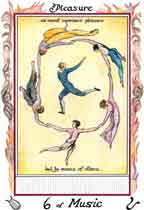 This
card is a collage of two watercolors, a circle of dancers around a central figure.
With six as the number of reciprocity and sharing, and Music as the suit of
love and emotions, this card is immediately understandable in its simplicity
and gracefulness. The card quotation confirms the social nature of human pleasure.
In fact, the word 'pleasure' itself comes from a word root meaning 'mutual understanding',
which clearly leads to mutual enjoyment. The central figure can also be seen
as a leader receiving the support and backing of his followers. Or the performance
artist responding to the enthusiasm of an audience. Or the individual who would
be at a loss without his friends and family. In this sense, the card represents
any network or support group that functions to assist and encourage the individual.
All of these are examples of emotional sharing that bring deep satisfaction.
This
card is a collage of two watercolors, a circle of dancers around a central figure.
With six as the number of reciprocity and sharing, and Music as the suit of
love and emotions, this card is immediately understandable in its simplicity
and gracefulness. The card quotation confirms the social nature of human pleasure.
In fact, the word 'pleasure' itself comes from a word root meaning 'mutual understanding',
which clearly leads to mutual enjoyment. The central figure can also be seen
as a leader receiving the support and backing of his followers. Or the performance
artist responding to the enthusiasm of an audience. Or the individual who would
be at a loss without his friends and family. In this sense, the card represents
any network or support group that functions to assist and encourage the individual.
All of these are examples of emotional sharing that bring deep satisfaction.
In a more general sense, this card
also represents the larger community of society that brings us life's most pleasant
experiences: our family and friends, neighbors and co-workers, our community,
and by extension the entire community of mankind that makes it possible for
us to function and enjoy life. This is the global dance of community.
When you get this card you are moving
effortlessly with the natural flow of energies. Harmony is restored after the
difficulties of 5 of Music. You freely give and receive. You may find yourself
the center of attention or the fulcrum of a wheel that moves about you. Or you
may be joining with others in such a way that your united energies can focus
through one individual or cause. Like songs and games that feature call-and-response,
a dynamic synthesis generates more movement and energy than just one factor
alone. This card is also about the constellating of sympathetic or related characteristics.
In the creative process, this is
when a variety of people or ingredients are brought together to produce an positive
or elegant outcome, sometimes quite spontaneously. This happens when collective
energies unite in exciting ways.
KEYWORDS: PLEASURABLE EXCHANGE
• FILIAL AND FRIENDLY SUPPORT NETWORKS • GIVING AND RECEIVING GIFTS
• HAPPY MEMORIES FROM THE PAST • BEING THE CENTER OF ATTENTION •
RECEIVING SUPPORT ¥ POSITIVE CONNECTIONS ¥ SURROUNDED BY GOOD FEELINGS •
HARMONIZATION OF ELEMENTS ¥
7 of Music
— Fancies
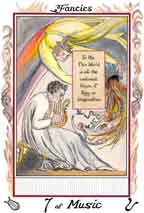 This
shows a poet-musician playing his lyre while, riding a rainbow above him, his
muse pours forth a cornucopia of gift-bearing sprites so as to inflame his creative
passions. This illustrates the lines in Gray's poem, "The Progress of Poesy":
This
shows a poet-musician playing his lyre while, riding a rainbow above him, his
muse pours forth a cornucopia of gift-bearing sprites so as to inflame his creative
passions. This illustrates the lines in Gray's poem, "The Progress of Poesy":
Hark, his hands
the lyre explore!
Bright-eyed Fancy, hov'ring o'er,
Scatters from her pictur'd urn
Thoughts that breathe, and words that burn.
As the "fancies" fly before
him, the poet-musician records them in music and poetry. The technical term
for this is synesthesia: the ability to experience one sense through another.
Once considered a form of madness, it can be seen as a special talent for perceiving
directly the spirit world that lies beyond the physical senses. Pamela Colman
Smith, artist of the Rider-Waite Tarot deck, who had the ability to see music,
explained that her drawings were "thoughts loosened and set free by the
spell of sound." She credited the "subconscious energy [that] lives
in them all." Debussy described her drawings of his music as "dreams
made visible."
The fancies demonstrate a variety
of things that can inspire us: one releases a bird of hope, another holds out
a locust of problems, a third offers snakes of wisdom in both hands (one emerging
from an egg), while a fourth holds the laurel sprig of victory. The rainbow
that bears "brighteyed Fancy" represents the mystical bridge between
the worlds of matter and imagination; it is the artist's causeway.
For Blake, the world of fancy is
reality, of which the so-called 'real' world of nature is but a reflection.
The making of images in the mind, or "spiritual existences," is the
process of imagination itself.
All forms are
perfect in the poet's mind, but these are not abstracted nor compounded
from nature but are from imagination.
In the card, the fire spilling from
the urn inflames your creativity, and the urn, decorated with laurels, signifies
the prophetic and victorious nature of your work, or your mind. Fancy and all
her little fancies are female, the anima or subconscious nature of the imagination.
On the negative side, this card can represent delusions, self-deceptions, and
inner confusion. Determine which fancies hold enough meaning and power to sustain
your work, and make their expression your goal.
In the creative process, this is
when you allow fantasy free reign. Your senses may crossfertilize (hearing colors,
for instance). As in daydreams, visions take form and then dissipate, permitting
you to rehearse future actions or try out seemingly impossible ideas.
KEYWORDS: IMAGINATIVE POSSIBILITIES
• INSPIRATIONAL FANTASIES • INNER VISION • ALTERED STATES •
SYNESTHESIA • DREAMS AND DAYDREAMS • EMOTIONAL DELUSIONS • EXPLOSIVE
EXPRESSION OF FEELINGS • MENTAL CONFUSION • CHOICES OR INDECISION
•
8 of Music
— Discontent
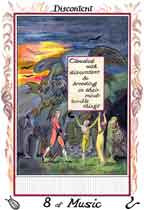 This
watercolor is from Gray's poem, "Ode on a Distant Prospect of Eton College,"
illustrating the lines:
This
watercolor is from Gray's poem, "Ode on a Distant Prospect of Eton College,"
illustrating the lines:
Alas, regardless
of their doom,
The little victims play!
...Yet see, how all around them wait The ministers of human fate...
The vultures of the mind
These mental spectres are identified:
at the left, with the snake of materialism wrapped around his arm, is jealousy.
At his feet is gluttony as a rooting hog. Next at right is devilish avarice,
clutching a running boy. Beneath is leonine pride or anger. At the extreme right,
sobbing despair grasps a maiden with a doll. Above her ballthrowing companion
is the serpent of flattery. Crowning all are the vultures of the mind, including
one who reaches down to menace the boy with the cricket stick. These spectres
are products of one's own discontent, and they prey upon the frivolous mind.
They are transparent because to Blake they are created by ego and therefore
unreal — quite different from the visions created by imagination, which
are more real than anything in nature.
Blake believes such mental monsters
are "the reasoning Spectre [that] stands between the vegetative man & his
immortal imagination." They can and must be conquered:
Each man is in
his Spectre's power
Untill the arrival of that hour,
When his Humanity awake
And cast his Spectre into the lake.
In the flames of the brightening
sky, birds and eagles soar as emblems of hope and creative possibilities. As
always in Blake, imagination is the key to personal freedom.
This is like being haunted by irrational
fears, feelings of inadequacy, and low self-esteem. You are psychologically
spooked or plagued by negativity. You may think that no one likes your work,
or that there are hideous flaws in it. You may be trying to avoid an ugly scene,
or cover up apprehensions or anger with a happy face. You need to re-evaluate
your friendships.
In the creative process, this is
when invisible demons of discontent make their presence felt, instigating psychodrama
and clouding your judgement. On the other hand, the imagination rampant can
produce 'monsters from the id.' Creativity is kin to lunacy, and sometimes you
will be visited by bizarre ideas in your search for expression.
KEYWORDS: EMOTIONAL DISAPPOINTMENT
OR DISSATISFACTION • ENERGY DRAIN • LOSS OF INNOCENCE • SELF-PITY
• PLAGUED BY EMOTIONAL TORMENTS • EMOTIONAL OVERINDULGENCE •
EMOTIONAL BREAKDOWN • SENSE OF THINGS OUT OF CONTROL •
9 of Music
— Happiness
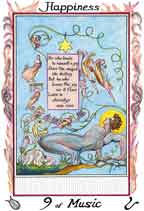 This
is from an illustration to Gray's poem, "Ode on the Spring." Blake
described it: "the purple year awaking from the roots of nature & the hours
suckling their flowery infants." The waking 'year' is young man. Naked,
he pushes himself up from the roots of nature, rising into Gray's "Cool
Zephyrs" — who he sees as two bare-breasted women — "whisp'ring
pleasure as they fly." His head is between us and the rising sun so that
it forms a natural halo, signaling his spiritual grace. Around him the "rosybosom'd
hours...disclose the long-expected flowers" (Gray's lines) as fairies extract
babies from amidst the blossoms and then, nursing them, float heavenward.Two
other fairies carry food and musical instruments. The man's ability to see such
things of the spirit shows his heightened psychic perception. A cuckoo balances
on a tendril above the Star of Venus, both symbols of springtime sexuality —
of which the young man is quite aware. All in all, the aroused 'year' has every
reason to be happy.
This
is from an illustration to Gray's poem, "Ode on the Spring." Blake
described it: "the purple year awaking from the roots of nature & the hours
suckling their flowery infants." The waking 'year' is young man. Naked,
he pushes himself up from the roots of nature, rising into Gray's "Cool
Zephyrs" — who he sees as two bare-breasted women — "whisp'ring
pleasure as they fly." His head is between us and the rising sun so that
it forms a natural halo, signaling his spiritual grace. Around him the "rosybosom'd
hours...disclose the long-expected flowers" (Gray's lines) as fairies extract
babies from amidst the blossoms and then, nursing them, float heavenward.Two
other fairies carry food and musical instruments. The man's ability to see such
things of the spirit shows his heightened psychic perception. A cuckoo balances
on a tendril above the Star of Venus, both symbols of springtime sexuality —
of which the young man is quite aware. All in all, the aroused 'year' has every
reason to be happy.
The window quotation is strongly
related to the concept of time, like the illustration itself (which depicts
the year and the hours), making the connection between time and happiness. The
"winged life" of the hours is like "joy as it flies" —
beautiful yet ephemeral. Nevertheless, happiness — like the flowers —
is ever-renewing and always at hand. As Blake said, "Those who want happiness
must stoop to find it; it is a flower that grows in every vale."
The sap is rising. You are blessed,
and feeling your power. Today you are complete and whole, healthy in mind and
spirit. You have done everything that needs doing. This is the card of direct,
spontaneous love and happiness. You accept whatever Spirit and Nature has to
bring you: today is a good day to die, or to live. In excess, you can become
egotistical, gluttonous, and self-serving, with expectations that only you can
provide happiness to those around you.
In the creative process, this is
when you are at your creative best — fully present in the eternal moment,
showered by gifts of spirit, improvising as you go, taking what comes without
demanding more.
KEYWORDS: EMOTIONAL SATISFACTION
& WELL-BEING • SENSUAL PLEASURES • UNCONDITIONAL LOVE • VISUALIZING
WHAT YOU WANT • GOOD HEALTH • PSYCHIC POWERS • SENSUAL EXCESS
• COMPLACENCY • SELF-INDULGENCE • SATIETY •
10 of
Music — Sublimity
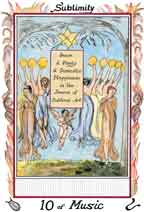 This
card is from a design to Gray's poem, "The Progress of Poesy," and
illustrates the lines:
This
card is from a design to Gray's poem, "The Progress of Poesy," and
illustrates the lines:
O'er Idalia's
velvet-green
The rosy-crowned loves are seen
On Cytherea's day
With antic Sports, and blue ey'd Pleasures
Frisking light in frolic measures:
Now pursuing, now retreating,
...To brisk notes in cadence beating
Decoding this passage and its illustration
reveals a focus upon love and sexuality as the basis of the sublime. 'Idalia'
was an ancient city on Cyprus famous for its temple of Aphrodite, the Greek
goddess of love and beauty, called Venus by the Romans. Born from the waves
near the small island of Cythera (her name means 'descendant of the foam'),
she is sometimes called 'Cytherea'. Her 'day' is Friday, reserved for sexual
fertility and marriage. Other signs of Aphrodite are the Star of Venus, and
the figure of lusty Cupid-Eros, who was Aphrodite's son. The timbrels (hand-drums)
being held aloft by the "loves" who are "in cadence beating"
could also be the famed mirrors of Venus, which were made of copper — itself
named after Aphrodite's isle of Cyprus. Aphrodite, a water goddess, was united
to fire by marrying Hephaestus (Vulcan), the god of the forge. The male/female
symbolism of the phallic flutes and round drums, is repeated in Cupid's bow
and violin, which also symbolizes magical powers and earthly perfection. This
portrayal of sublimity ('elevated state') is literalized by the fact that everyone
is dancing on air.
The window quotation extends the
meaning of this card by identifying it as the foundation of creativity. Emotional
and sexual satisfaction are the wellsprings of perfection in art, according
to Blake. The music and dance of the maidens is the product of joy, not melancholy,
focusing on the divine energies of sex and love.
You may have a talent for bringing
people together. In this card we see collaboration, a group choreography, individuals
in step, or sharing a vision. Through eros (love), we come to a state of vibrational
resonance. You may be involved in something of high spiritual, moral, or intellectual
worth. Your noblest characteristics are coming out. Everything is working well
together. This shows moments of shared exultation.
In the creative process, this is
harmonic convergence — the synchronization of rhythmic systems into a single
divine note. The combined instruments and energies of the project and its components
oscillate into resonance, building one upon another into sublime spiritual eros.
KEYWORDS: THE DANCE OF LOVE AND
LIFE • PERFECT EMOTIONAL SATISFACTION • COMPLETE GOOD FORTUNE •
"AT HOME" WITH SELF AND OTHERS • DOMESTIC AND ARTISTIC BLISS
• COLLABORATION AND TEAMWORK • DIVINE CHOREOGRAPHY • SOCIAL HARMONY
• SEXUAL AND SPIRITUAL WHOLENESS • PSYCHIC MASTERY •
The Person
Cards
The central images used in the four
Person Cards of the Suit of Music, like the ten Number Cards, are all from the
Blake's watercolor designs to Poems by Mr. Gray. In each Person Card of the
suit, as in each Number Card, the window contains a thematic quotation from
Blake that emulates lyrics to music.
Angel
of Music
(Air of Fire — Mind of Passion)
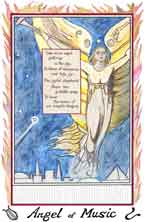 This
image is from the title page of Gray's poem, "Ode for Music." As in
3 of Music, this angel is a seraph ('radiant one'), called "Fame."
But here the seraph holds two trumpets, not one (because fame, according to
Milton, has two mouths) — and descends instead of rises. Trumpets were
anciently used to herald the new and full moons, associating this angel with
the moon and the emotions. Trailing flames of compassion, the angel touches
down into the world using the right or spiritual foot. Crowned by a single star
of intellectual inspiration, its spiritual vision is directed upward to heaven.
The domes and pyramids of London, which Blake associates with the Suit of Music,
symbolize the city's materialism and commerce, while the spires and steeples
represent its religion and arts. To men of all pursuits, the Angel of Music
announces (for 'fame' means 'to speak') divine forgiveness for the evils of
society, and brings the blessing of aesthetic sensibility. At its right, a star
shoots upwards, signaling a crack in the firmament through which the angelic
energies appear; it is also a sign of psychic abilities associated with this
card.
This
image is from the title page of Gray's poem, "Ode for Music." As in
3 of Music, this angel is a seraph ('radiant one'), called "Fame."
But here the seraph holds two trumpets, not one (because fame, according to
Milton, has two mouths) — and descends instead of rises. Trumpets were
anciently used to herald the new and full moons, associating this angel with
the moon and the emotions. Trailing flames of compassion, the angel touches
down into the world using the right or spiritual foot. Crowned by a single star
of intellectual inspiration, its spiritual vision is directed upward to heaven.
The domes and pyramids of London, which Blake associates with the Suit of Music,
symbolize the city's materialism and commerce, while the spires and steeples
represent its religion and arts. To men of all pursuits, the Angel of Music
announces (for 'fame' means 'to speak') divine forgiveness for the evils of
society, and brings the blessing of aesthetic sensibility. At its right, a star
shoots upwards, signaling a crack in the firmament through which the angelic
energies appear; it is also a sign of psychic abilities associated with this
card.
In the window quotation, Blake tells
of a sweetheart, who, "when she speaks, the voice of heaven I hear."
Thus the "music of an angel's tongue" is the soft lullaby of love
that creates "times of innocence and joy" despite the complexities
and evils of civic life. The angel brings a cleansing freshness of possibility.
This card is the part of yourself
or another that channels love for spiritual growth and awareness. Optimistic
and open-hearted, you are able to overlook foibles and faults that others cannot,
and you are blessed with friends and admirers. You are a voice of moderation
and compassion, unafraid to announce your feelings or to step into the fray
to defend others who are needy or disadvantaged. You bring a clear insight into
confused or mixed situations, and may be psychically gifted. On the negative
side, you are opportunistic and may resort to duplicity, speaking from both
sides of your mouth. You are hot-tempered and sometimes act too quickly, lacking
adequate grounding in the situation at hand.
The archangel Uriel can be associated
with the Suit of Music, reputedly being the bringer of both alchemy and qabalah
to mankind. Uriel ('fire from God') is the angel of salvation, and the fiery
guardian of Eden's gates. Although Uriel is unrelated to the Angel of Music,
they can both be regarded as emissaries of transformative energies.
In the creative process, this is
when you feel an inrush of passionate excitement about what you are doing, when
your heart sings with a vision of the imaginative possibilities that are appearing
or coming down to you.
KEYWORDS: EMOTIONAL BREAKTHROUGH
• COMPASSION • APPROACH OF SPIRITUAL GRACE • INCREASE OF AESTHETIC
AWARENESS • LUNAR INSIGHTS. FORGIVING OF PERSONAL AND SOCIAL FAULTS •
PSYCHIC POWERS • QUICK TO DISPLAY EMOTIONS • OPPORTUNISM. DUPLICITY
•
Child
of Music
(Earth of Fire — Spirit of Passion)
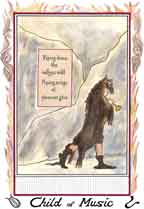 This
card is from a design to Gray's poem, "The Progress of Poesy," illustrating
the lines:
This
card is from a design to Gray's poem, "The Progress of Poesy," illustrating
the lines:
Where shaggy forms
o'er ice-built mountains roam,
The Muse has broke the twilight gloom...
She deigns to hear the savage youth...
Th' unconquerable mind, and Freedom's holy flame.
The piping boy in leggings and
wolf skins represents the primal feelings, outwardly wild and fierce, but inwardly
innocent, tamed by love's lyrical power. The starkness of the 'ice-built mountains'
and the primitiveness of the animal skin's 'shaggy form' emphasize the preciousness
of the boy's humanity and the sweetness of his private tune — he is a 'sheep
in wolf's clothing'. Obviously oblivious to his surroundings, he communes deeply
with an inner muse. No matter how barren his environment, or how crude and unkempt
his raiment, his songs are intuitive expressions of his feelings, and personal
communications from his dreams and subconscious mind. Although he is emotionally
independent and has a thick skin, he is inwardly vulnerable and moody. His willingness
to take risks for love is part of his inherent valor. He strides forward confidently
with his right or loving foot, and even the menacing persona on his back proceeds
with its right paw first; thus the fearsome child is on the path of goodness.
The emphasis on nature symbols in this card shows its relation to elemental
earth as the source of primal feelings.
This is the part of yourself or
another that plays on the most primitive of feelings. You are an empath proceeding
alone into the psychic realm or into dreams. Emotionally vulnerable, you may
be singing the blues, and turn away from human companionship. This can be your
inner child whose trust has been betrayed, and retreats into insecurity or reclusiveness.
You play-act with animal magnetism to see who will respond to your wild tune.
This individual may become wrapped in fantasies and illusions of reality.
In the creative process, this when
you explore the possibilities of improvisation, led by heart and soul. You fall
in love with your own imagination.
KEYWORDS: SELF-COMMUNICATION
• BEING TOUCH WITH ONE'S OWN FEELINGS • SHARING OF VISIONS AND DREAMS
VIA CREATIVE EXPRESSION • DISGUISED EMOTIONAL VULNERABILITY • WILLINGNESS
TO TAKE EMOTIONAL RISKS •
Woman
of Music
(Water of Fire — Matter of Passion)
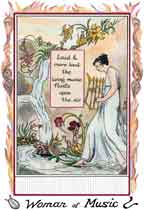 This
card is from a design to GrayÕs poem, "The Progress of Poesy," illustrating
the lines:
This
card is from a design to GrayÕs poem, "The Progress of Poesy," illustrating
the lines:
Awake, ®olian
lyre, awake,
And give to rapture all thy trembling strings.
From Helicon's harmonious springs
A thousand rills their mazy progress take:
The laughing flowers, that round them blow,
Drink life and fragrance as they flow.
Mt. Helicon's anciently famous springs
of Aganippe and Hippocrene (hippo=horse + krene=spring, because unearthed by
the winged horse Pegasus), are the home of the Greek muses and thus the birthplace
of music and poetry. Their waters inspired whoever drank them, and the fragrant
flowers surrounding them were reputed to deprive snakes of their venom. Helicon
was named after the goddess Helice, a virgin form of Hecate (see II—Mystery)
whose name means 'willow' in Greek, for willows were planted by streams and
their wands used for divination. This Grecian muse is Helice, and like her namesake
willow, she merges with the stream — right foot forward to indicate her
spiritual qualities. The 'trembling strings' of her lyre (from ®olus, the wind-god)
are the song of the wind in her branches. The humanized flowers along the rills
of the stream all drink and toast the inspirational waters, a metaphor for Gray's
"rich stream of music."
The muse or Woman of Music is here
associated with fire (in the border), air (the ®olian wind), water (the
springs), and with earth (the living flowers). She is the Enchantress who channels
and integrates energy, thoughts, feelings, and spirit. Her "living music"
is "loud" and clear. Compare this card image with the Queen of Cups
in the traditional Tarot.
This is the part of yourself or
another who listens to the inner chords for life's ecstatic moments. You seek
pleasure and tranquility, are naturally graceful and gentle, and enjoy all the
senses. This person excels at 'diffuse consciousness' — an instinct for
taking everything in without focusing on anything in particular. She may be
very psychic, and easily reflects other people's feelings and projections. In
the face of harsh realities, she may escape into solitude, addictions, or anodynes.
Loving life, she is likely to vigorously laugh with joy, or unashamedly wail
with sorrow.
In the creative process, this is
when you vibrate in tune with everything around you, sensitively aware of life
energy in all its forms, from which you create something new through the filter
of your own consciousness.
KEYWORDS: EMOTIONAL DEPTH •
FLOWING PSYCHIC SKILLS • SOURCE OF INSPIRATION TO OTHERS • ENCHANTING
PERSONAL MANNER • MULTIPLE AFFINITIES AND TALENTS •
Man
of Music
(Fire of Fire — Passion of Feelings)
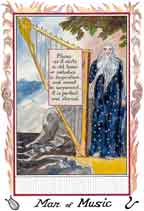 This
card is from the title design to Gray's poem, "The Bard," but could
illustrate Blake's own lines from his Songs of Experience:
This
card is from the title design to Gray's poem, "The Bard," but could
illustrate Blake's own lines from his Songs of Experience:
Hear the voice
of the bard!
Who present, past, & future sees
Whose ears have heard,
The holy word,
That walkÕd among the ancient trees.
Bards were Celtic minstrels who
acted as heralds, and sang heroic odes at celebrations and festivals. The Man
of Music is such a bard, a wise counselor and gifted visionary. His hoary beard
and advanced age signify his emotional control and vast experience. A good term
for him is wizard ('wise one'), a member of the magical establishment. He stands
next to the sea of time & space (the material world) and beneath the branches
of the "ancient trees" where walked the "holy word" —
hence, he mediates between the worlds of matter and spirit; he is a shaman (medium)
who sings the sagas of the soul. His mystical authority is asserted by his starry
magician's robe, and, crowning his golden harp, by an angelic muse, which itself
holds another, miniature harp. The bard's imagination roams freely between the
mundane and the sacred, between fantasy and reality, between the past and the
future.
Blake's window quotation states
that imagination is ageless — artists and poets of old created perfect
works, as will those of the future. Bardic inspiration is not supplanted by
our own; nor will our realized visions be devalued by those of artists yet to
come.
This is the part of yourself or
another who is a spokesperson for the soul, interpreting the pregnant sounds
and deep currents of life. You show maturity of emotion with a real concern
for others. You are wonderfully imaginative but need an audience to appreciate
you. This individual is old-fashioned, and devoted to tradition. In the extreme,
he may be an idealist out of touch with reality, or live in a fantasy world
of self-delusion. His sensitivity may lead to drowning his feelings in addiction
or neurosis.
In the creative process, this is
when you offer yourself as a servant of the life force, dedicating yourself
to what you love, to helping others, or creating something beautiful.
KEYWORDS: EMOTIONAL CONTROL AND
SELF-DISCIPLINE • MEDIUMSHIP • SHAMANISM • WIZARDRY • WISE
COUNSEL • SOULFUL EXPRESSION • CREATIVE MASTERY • LIVING IN FANTASY
• SELF-DELUSION •
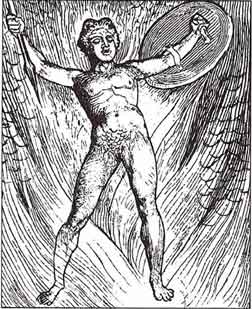
 This
card shows a naked youth astride a giant swan ascending in full flight. In one
hand he holds an upraised lyre and in the other a pair of reins. The opening
illustration to Gray's book, it represents Genius being carried by Inspiration.
In Blake's symbology, upward flight signifies energy — the life force associated
with man's desires. The swan embodies purity, grace, and fertility, in union
with the youth's naked innocence. In Greek mythology, the swan is the mount
of Apollo, the god of music whose instrument was a lyre, and who Blake related
to the divine imagination. The lyre is the instrument of Luvah, the Zoa of Music.
Its shape symbolizes sexual energy, for the sounds rising from between its horns
are said to have initiated the birth of the universe. Traditionally, the lyre
has either seven strings (representing the planets) or twelve strings (representing
the astrological signs), and thus unites the forces of the cosmos. The reins
in his right hand show that you, as Apollo/Luvah, can control and direct these
creative energies.
This
card shows a naked youth astride a giant swan ascending in full flight. In one
hand he holds an upraised lyre and in the other a pair of reins. The opening
illustration to Gray's book, it represents Genius being carried by Inspiration.
In Blake's symbology, upward flight signifies energy — the life force associated
with man's desires. The swan embodies purity, grace, and fertility, in union
with the youth's naked innocence. In Greek mythology, the swan is the mount
of Apollo, the god of music whose instrument was a lyre, and who Blake related
to the divine imagination. The lyre is the instrument of Luvah, the Zoa of Music.
Its shape symbolizes sexual energy, for the sounds rising from between its horns
are said to have initiated the birth of the universe. Traditionally, the lyre
has either seven strings (representing the planets) or twelve strings (representing
the astrological signs), and thus unites the forces of the cosmos. The reins
in his right hand show that you, as Apollo/Luvah, can control and direct these
creative energies.  This
card shows Reason looking down from the clouds of matter, hearkening to the
gentle vibrations of Imagination's song — as the scientist Isaac Newton
listens to John Milton sing — illustrating Gray's lines from his "Ode
to Music":
This
card shows Reason looking down from the clouds of matter, hearkening to the
gentle vibrations of Imagination's song — as the scientist Isaac Newton
listens to John Milton sing — illustrating Gray's lines from his "Ode
to Music":  This
card is a collage of two illustrations for Gray's poem, "Ode for Music."
It depicts an ascending seraph with many-plumed wings, trumpeting a great musical
riff upwards into the heavens. Represents the vitality and and joy of life,
its upward movement suggests growth, especially of spiritual awareness. The
seraph ('radiant, burning one') is the highest order of angel, one who sounds
the music of the spheres (the rotating planets). Its celestial passion is evident
in the color of its wings, complemented by the flames in the border. On its
tunic we see dancing figures of energy like those in the 10 of Music. Below,
two small birds on looping tendrils join in the song. Nature cooperates with
spirit, forming an exuberant chorus. Angel, birds, and horn all symbolize transcendent
communication. The two birds independently signify fellowship and friendship.
This
card is a collage of two illustrations for Gray's poem, "Ode for Music."
It depicts an ascending seraph with many-plumed wings, trumpeting a great musical
riff upwards into the heavens. Represents the vitality and and joy of life,
its upward movement suggests growth, especially of spiritual awareness. The
seraph ('radiant, burning one') is the highest order of angel, one who sounds
the music of the spheres (the rotating planets). Its celestial passion is evident
in the color of its wings, complemented by the flames in the border. On its
tunic we see dancing figures of energy like those in the 10 of Music. Below,
two small birds on looping tendrils join in the song. Nature cooperates with
spirit, forming an exuberant chorus. Angel, birds, and horn all symbolize transcendent
communication. The two birds independently signify fellowship and friendship.
 This
card is a collage of two watercolors, and depicts an ancient bard playing his
harp at a ceremony, while in the background a boy in a tree leans to hand down
a nest to a girl below. The bard, a favorite figure of both Blake and Gray,
represents the mythic poet-musician-prophet who speaks the truth (soothsays)
about past and present, and can divine the future as well. (See Man of Music.)
The scene in this card is similar to that illustrating Blake's poem from Songs
of Innocence, "The Voice of the Ancient Bard," which shows a bard
surrounded by young people as he sings: "Youth of delight come hither,
and see the...image of truth new born." With powers indicated by his starry
robe, the bard is an intermediary between the worlds of matter and imagination.
His eyes are closed as he looks within and muses upon what he sees with his
spiritual sight. In general, the bard signifies the passion of wisdom. As the
window quotation states, this is Blake himself, conveying his musings in words
and song to audiences old and young.
This
card is a collage of two watercolors, and depicts an ancient bard playing his
harp at a ceremony, while in the background a boy in a tree leans to hand down
a nest to a girl below. The bard, a favorite figure of both Blake and Gray,
represents the mythic poet-musician-prophet who speaks the truth (soothsays)
about past and present, and can divine the future as well. (See Man of Music.)
The scene in this card is similar to that illustrating Blake's poem from Songs
of Innocence, "The Voice of the Ancient Bard," which shows a bard
surrounded by young people as he sings: "Youth of delight come hither,
and see the...image of truth new born." With powers indicated by his starry
robe, the bard is an intermediary between the worlds of matter and imagination.
His eyes are closed as he looks within and muses upon what he sees with his
spiritual sight. In general, the bard signifies the passion of wisdom. As the
window quotation states, this is Blake himself, conveying his musings in words
and song to audiences old and young.  This
card depicts the "unlettered Muse" of Gray's most famous poem, "Elegy
Written in a Country Churchyard," standing amidst several tombstones. Her
finger traces the letters of the words, DUST THOU ART, beneath which the inscription
says, HERE LIETH WM BLAKE. As a spirit figure, the muse touching the gravestone
signifies the possession of psychic powers. The tombstones generically symbolize
the death of love, emotional loss, broken vows, or plans overturned. They can
also signify one's own buried emotions. Gray's poem is a melancholy speculation
on mortality and immortality; Blake's name upon the tomb is his own ironic gesture
of empathy.
This
card depicts the "unlettered Muse" of Gray's most famous poem, "Elegy
Written in a Country Churchyard," standing amidst several tombstones. Her
finger traces the letters of the words, DUST THOU ART, beneath which the inscription
says, HERE LIETH WM BLAKE. As a spirit figure, the muse touching the gravestone
signifies the possession of psychic powers. The tombstones generically symbolize
the death of love, emotional loss, broken vows, or plans overturned. They can
also signify one's own buried emotions. Gray's poem is a melancholy speculation
on mortality and immortality; Blake's name upon the tomb is his own ironic gesture
of empathy.  This
card is a collage of two watercolors, a circle of dancers around a central figure.
With six as the number of reciprocity and sharing, and Music as the suit of
love and emotions, this card is immediately understandable in its simplicity
and gracefulness. The card quotation confirms the social nature of human pleasure.
In fact, the word 'pleasure' itself comes from a word root meaning 'mutual understanding',
which clearly leads to mutual enjoyment. The central figure can also be seen
as a leader receiving the support and backing of his followers. Or the performance
artist responding to the enthusiasm of an audience. Or the individual who would
be at a loss without his friends and family. In this sense, the card represents
any network or support group that functions to assist and encourage the individual.
All of these are examples of emotional sharing that bring deep satisfaction.
This
card is a collage of two watercolors, a circle of dancers around a central figure.
With six as the number of reciprocity and sharing, and Music as the suit of
love and emotions, this card is immediately understandable in its simplicity
and gracefulness. The card quotation confirms the social nature of human pleasure.
In fact, the word 'pleasure' itself comes from a word root meaning 'mutual understanding',
which clearly leads to mutual enjoyment. The central figure can also be seen
as a leader receiving the support and backing of his followers. Or the performance
artist responding to the enthusiasm of an audience. Or the individual who would
be at a loss without his friends and family. In this sense, the card represents
any network or support group that functions to assist and encourage the individual.
All of these are examples of emotional sharing that bring deep satisfaction.
 This
shows a poet-musician playing his lyre while, riding a rainbow above him, his
muse pours forth a cornucopia of gift-bearing sprites so as to inflame his creative
passions. This illustrates the lines in Gray's poem, "The Progress of Poesy":
This
shows a poet-musician playing his lyre while, riding a rainbow above him, his
muse pours forth a cornucopia of gift-bearing sprites so as to inflame his creative
passions. This illustrates the lines in Gray's poem, "The Progress of Poesy":
 This
watercolor is from Gray's poem, "Ode on a Distant Prospect of Eton College,"
illustrating the lines:
This
watercolor is from Gray's poem, "Ode on a Distant Prospect of Eton College,"
illustrating the lines:  This
is from an illustration to Gray's poem, "Ode on the Spring." Blake
described it: "the purple year awaking from the roots of nature & the hours
suckling their flowery infants." The waking 'year' is young man. Naked,
he pushes himself up from the roots of nature, rising into Gray's "Cool
Zephyrs" — who he sees as two bare-breasted women — "whisp'ring
pleasure as they fly." His head is between us and the rising sun so that
it forms a natural halo, signaling his spiritual grace. Around him the "rosybosom'd
hours...disclose the long-expected flowers" (Gray's lines) as fairies extract
babies from amidst the blossoms and then, nursing them, float heavenward.Two
other fairies carry food and musical instruments. The man's ability to see such
things of the spirit shows his heightened psychic perception. A cuckoo balances
on a tendril above the Star of Venus, both symbols of springtime sexuality —
of which the young man is quite aware. All in all, the aroused 'year' has every
reason to be happy.
This
is from an illustration to Gray's poem, "Ode on the Spring." Blake
described it: "the purple year awaking from the roots of nature & the hours
suckling their flowery infants." The waking 'year' is young man. Naked,
he pushes himself up from the roots of nature, rising into Gray's "Cool
Zephyrs" — who he sees as two bare-breasted women — "whisp'ring
pleasure as they fly." His head is between us and the rising sun so that
it forms a natural halo, signaling his spiritual grace. Around him the "rosybosom'd
hours...disclose the long-expected flowers" (Gray's lines) as fairies extract
babies from amidst the blossoms and then, nursing them, float heavenward.Two
other fairies carry food and musical instruments. The man's ability to see such
things of the spirit shows his heightened psychic perception. A cuckoo balances
on a tendril above the Star of Venus, both symbols of springtime sexuality —
of which the young man is quite aware. All in all, the aroused 'year' has every
reason to be happy.  This
card is from a design to Gray's poem, "The Progress of Poesy," and
illustrates the lines:
This
card is from a design to Gray's poem, "The Progress of Poesy," and
illustrates the lines:  This
image is from the title page of Gray's poem, "Ode for Music." As in
3 of Music, this angel is a seraph ('radiant one'), called "Fame."
But here the seraph holds two trumpets, not one (because fame, according to
Milton, has two mouths) — and descends instead of rises. Trumpets were
anciently used to herald the new and full moons, associating this angel with
the moon and the emotions. Trailing flames of compassion, the angel touches
down into the world using the right or spiritual foot. Crowned by a single star
of intellectual inspiration, its spiritual vision is directed upward to heaven.
The domes and pyramids of London, which Blake associates with the Suit of Music,
symbolize the city's materialism and commerce, while the spires and steeples
represent its religion and arts. To men of all pursuits, the Angel of Music
announces (for 'fame' means 'to speak') divine forgiveness for the evils of
society, and brings the blessing of aesthetic sensibility. At its right, a star
shoots upwards, signaling a crack in the firmament through which the angelic
energies appear; it is also a sign of psychic abilities associated with this
card.
This
image is from the title page of Gray's poem, "Ode for Music." As in
3 of Music, this angel is a seraph ('radiant one'), called "Fame."
But here the seraph holds two trumpets, not one (because fame, according to
Milton, has two mouths) — and descends instead of rises. Trumpets were
anciently used to herald the new and full moons, associating this angel with
the moon and the emotions. Trailing flames of compassion, the angel touches
down into the world using the right or spiritual foot. Crowned by a single star
of intellectual inspiration, its spiritual vision is directed upward to heaven.
The domes and pyramids of London, which Blake associates with the Suit of Music,
symbolize the city's materialism and commerce, while the spires and steeples
represent its religion and arts. To men of all pursuits, the Angel of Music
announces (for 'fame' means 'to speak') divine forgiveness for the evils of
society, and brings the blessing of aesthetic sensibility. At its right, a star
shoots upwards, signaling a crack in the firmament through which the angelic
energies appear; it is also a sign of psychic abilities associated with this
card.  This
card is from a design to Gray's poem, "The Progress of Poesy," illustrating
the lines:
This
card is from a design to Gray's poem, "The Progress of Poesy," illustrating
the lines:  This
card is from a design to GrayÕs poem, "The Progress of Poesy," illustrating
the lines:
This
card is from a design to GrayÕs poem, "The Progress of Poesy," illustrating
the lines:  This
card is from the title design to Gray's poem, "The Bard," but could
illustrate Blake's own lines from his Songs of Experience:
This
card is from the title design to Gray's poem, "The Bard," but could
illustrate Blake's own lines from his Songs of Experience: 